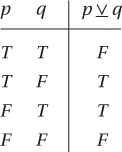If p and q are statements, then the statement ‘p or q’ where exclusive disjunction is intended, often written as ‘p xor q’ or p ⊻ q, is true only if exactly one of p, q is true. The truth table is therefore as follows:

The set-theoretic equivalent of exclusive disjunction is symmetric difference. See also inclusive disjunction.
- website
- website defacement
- Web site forgery
- Web site promotion
- web spider
- Webster–Ashburton Treaty (1842)
- Web trap
- Web wrap agreement
- Webzine
- Wedderburn, Robert William Maclagan (1947–75)
- Wedderburn’s little theorem
- wedge
- wedge-edge trap
- wedge tornado
- weed
- weeping
- weevil
- Wegener, Alfred (1880–1930)
- Wegener, Alfred Lothar
- clastic
- clastic dyke
- clastic rock
- clastogenic flow
- clathrate
- clathrin